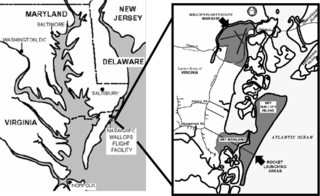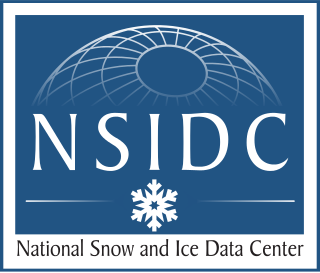
The National Oceanic and Atmospheric Administration is a scientific and regulatory agency within the Washington, D.C.–based United States Department of Commerce, headquartered in Silver Spring, Maryland.

The Laboratory for Atmospheric and Space Physics (LASP) is a research organization at the University of Colorado Boulder. LASP is a research institute with over one hundred research scientists ranging in fields from solar influences, to Earth's and other planetary atmospherics processes, space weather, space plasma and dusty plasma physics. LASP has advanced technical capabilities specializing in designing, building, and operating spacecraft and spacecraft instruments.

The Goddard Space Flight Center (GSFC) is a major NASA space research laboratory located approximately 6.5 miles (10.5 km) northeast of Washington, D.C. in Greenbelt, Maryland, United States. Established on May 1, 1959 as NASA's first space flight center, GSFC employs about 10,000 civil servants and contractors. Named for American rocket propulsion pioneer Robert H. Goddard, it is one of ten major NASA field centers. GSFC is partially within the former Goddard census-designated place; it has a Greenbelt mailing address.

Wallops Flight Facility (WFF) is a rocket launch site on Wallops Island on the Eastern Shore of Virginia, United States, just east of the Delmarva Peninsula and approximately 100 miles (160 km) north-northeast of Norfolk. The facility is operated by the Goddard Space Flight Center in Greenbelt, Maryland, and primarily serves to support science and exploration missions for NASA and other Federal agencies. WFF includes an extensively instrumented range to support launches of more than a dozen types of sounding rockets; small expendable suborbital and orbital rockets; high-altitude balloon flights carrying scientific instruments for atmospheric and astronomical research; and, using its Research Airport, flight tests of aeronautical research aircraft, including unmanned aerial vehicles.

The University of Alabama in Huntsville (UAH) is a public research university in Huntsville, Alabama. The university is accredited by the Southern Association of Colleges and Schools and comprises eight colleges: arts, humanities & social sciences; business; education; engineering; honors; nursing; science; and graduate. The university's enrollment is approximately 10,000. It is part of the University of Alabama System and is classified among "R1: Doctoral Universities: Very High Research Activity".

The National Snow and Ice Data Center (NSIDC) is a United States information and referral center in support of polar and cryospheric research. NSIDC archives and distributes digital and analog snow and ice data and also maintains information about snow cover, avalanches, glaciers, ice sheets, freshwater ice, sea ice, ground ice, permafrost, atmospheric ice, paleoglaciology, and ice cores.

The Vikram Sarabhai Space Centre (VSSC) is a major space research centre of the Indian Space Research Organisation (ISRO), focusing on rocket and space vehicles for India's satellite programme. It is located in Trivandrum, in the Indian state of Kerala.

The Biocomplexity Institute of Virginia Tech was a research institute specializing in bioinformatics, computational biology, and systems biology. The institute had more than 250 personnel, including over 50 tenured and research faculty. Research at the institute involved collaboration in diverse disciplines such as mathematics, computer science, biology, plant pathology, biochemistry, systems biology, statistics, economics, synthetic biology and medicine. The institute developed -omic and bioinformatic tools and databases that can be applied to the study of human, animal and plant diseases as well as the discovery of new vaccine, drug and diagnostic targets.

The Global Learning and Observations to Benefit the Environment (GLOBE) Program is a worldwide hands-on, science and education program focusing on the environment, now active in over 120 countries worldwide. It works to promote the teaching and learning of science, enhance environmental literacy and stewardship, and promote scientific discovery. Students and teachers collect data and perform research in collaboration with scientists from numerous international agencies, and their work is made accessible through the GLOBE website.

The Cooperative Institute for Research in Environmental Sciences (CIRES) is a research institute that is sponsored jointly by the National Oceanic and Atmospheric Administration (NOAA) Office of Oceanic and Atmospheric Research (OAR) and the University of Colorado Boulder (CU). CIRES scientists study the Earth system, including the atmosphere, hydrosphere, cryosphere, biosphere, and geosphere, and communicate these findings to decision makers, the scientific community, and the public.

The Solar Dynamics Observatory (SDO) is a NASA mission which has been observing the Sun since 2010. Launched on 11 February 2010, the observatory is part of the Living With a Star (LWS) program.

The US National Center for Atmospheric Research is a US federally funded research and development center (FFRDC) managed by the nonprofit University Corporation for Atmospheric Research (UCAR) and funded by the National Science Foundation (NSF). NCAR has multiple facilities, including the I. M. Pei-designed Mesa Laboratory headquarters in Boulder, Colorado. Studies include meteorology, climate science, atmospheric chemistry, solar-terrestrial interactions, environmental and societal impacts.

The Aeronomy of Ice in the Mesosphere is a NASA satellite launched in 2007 to conduct a planned 26-month study of noctilucent clouds (NLCs). It is the ninetieth Explorer program mission and is part of the NASA-funded Small Explorer program (SMEX).
The Space Systems and Control Lab (SSCL), is a laboratory based at Iowa State University (ISU) in Ames, IA. SSCL focuses on space systems and has a massive number of independent projects. Within its department, the SSCL also has an AABL Wind and Gust Tunnel, Anechoic Chamber, Icing Tunnel, Neutral Buoyancy Tank, Rotational Diamond Anvil Cell, and a Tornado Simulator.

The Indian Centre for Space Physics (ICSP) is an Indian non-profit research organisation dedicated to carrying out advanced research in astronomy, astrophysics and space science. It is a sister institute of the University of Calcutta and the University of Gour Banga. It is located in the southern part of the city of Kolkata. It is located to its new Integrated campus on the Eastern metropolitan bypass 70 meters from Jyotirindra Nandy Metro station behind Metro Cash and Carry. Its Ionospheric and Earthquake Research Centre and optical observatory (IERCOO) where a 24-inch optical telescope (Vashista) has been installed is located at Sitapur, West Medinipur, where Astrotourism facility is opened. School and college students regularly carry out sky watching using its 10-inch telescope (Arundhati). The ground floor of the Integrated Campus has Museum of Astronomy and Space Museum.

The Verification of the Origins of Rotation in Tornadoes Experiment are field experiments that study tornadoes. VORTEX1 was the first time scientists completely researched the entire evolution of a tornado with an array of instrumentation, enabling a greater understanding of the processes involved with tornadogenesis. A violent tornado near Union City, Oklahoma was documented in its entirety by chasers of the Tornado Intercept Project (TIP) in 1973. Their visual observations led to advancement in understanding of tornado structure and life cycles.
UNAVCO was a non-profit university-governed consortium that facilitated geology research and education using geodesy.

Planetary science is the scientific study of planets, celestial bodies and planetary systems and the processes of their formation. It studies objects ranging in size from micrometeoroids to gas giants, aiming to determine their composition, dynamics, formation, interrelations and history. It is a strongly interdisciplinary field, which originally grew from astronomy and Earth science, and now incorporates many disciplines, including planetary geology, cosmochemistry, atmospheric science, physics, oceanography, hydrology, theoretical planetary science, glaciology, and exoplanetology. Allied disciplines include space physics, when concerned with the effects of the Sun on the bodies of the Solar System, and astrobiology.

Student Nitric Oxide Explorer, was a NASA small scientific satellite which studied the concentration of nitric oxide in the thermosphere. It was launched in 1998 as part of NASA's Explorer program. The satellite was the first of three missions developed within the Student Explorer Demonstration Initiative (STEDI) program funded by the NASA and managed by the Universities Space Research Association (USRA). STEDI was a pilot program to demonstrate that high-quality space science can be carried out with small, low-cost free-flying satellites on a time scale of two years from go-ahead to launch. The satellite was developed by the University of Colorado Boulder's Laboratory for Atmospheric and Space Physics (LASP) and had met its goals by the time its mission ended with reentry in December 2003.
















